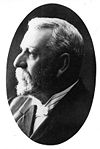Western Australian state election, 1901
|
|
|||||||||||||||||||||||||||||||||||||||||||||||||||||||
|
|||||||||||||||||||||||||||||||||||||||||||||||||||||||
|
|||||||||||||||||||||||||||||||||||||||||||||||||||||||
|
|||||||||||||||||||||||||||||||||||||||||||||||||||||||
George Throssell
Ministerialist
Elections were held in the state of Western Australia on 24 April 1901 to elect 50 members to the Western Australian Legislative Assembly. It was the first election to take place since responsible government without the towering presence of Premier Sir John Forrest, who had left state politics two months earlier to enter the first Federal parliament representing the Division of Swan, and the first state parliamentary election to follow the enactment of women's suffrage in 1899.
The Ministerial group, led by Forrest's nominated successor George Throssell, ran a half-hearted campaign for government, with Throssell saying in a policy speech that while he would continue to serve as Premier if required, "it was not the class of political life he desired, as it interfered too much with his leisure." Meanwhile, the Opposition had no clear leader, with the Parliamentary leader Frederick Illingworth and George Leake, who was seeking to return to Parliament in the election, both apparently contenders. The groups were neither formal nor organised, with many members and candidates professing rather confused allegiances and running their own campaigns on local issues.
Following the introduction of payment of members in 1900, which effectively allowed electors without independent means to sit in Parliament, the Labour Party offered 22 candidates to the voters compared to three at the previous election, each of which was pledged to the party's platform. The Westralian Worker newspaper, launched six months earlier, was used to publicise the campaign. They ultimately won six seats, of which five were located in the Goldfields.
...
Wikipedia



